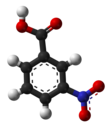| |||
| Names | |||
|---|---|---|---|
| Preferred IUPAC name 3-Nitrobenzoic acid | |||
| Other names m-Nitrobenzoic acid | |||
| Identifiers | |||
3D model (JSmol) | |||
| ChEBI | |||
| ChEMBL | |||
| ChemSpider | |||
| ECHA InfoCard | 100.004.099 | ||
PubChem CID | |||
| UNII | |||
CompTox Dashboard (EPA) | |||
| |||
| |||
| Properties | |||
| C7H5NO4 | |||
| Molar mass | 167.12 g/mol | ||
| Appearance | cream-colored solid | ||
| Density | 1.494 g/cm3 | ||
| Melting point | 139 to 141 °C (282 to 286 °F; 412 to 414 K) | ||
| 0.24 g/100 mL (15 °C) | |||
| Acidity (pKa) | 3.47 (in water) [1] | ||
| −80.22·10−6 cm3/mol | |||
| Related compounds | |||
Related compounds | Benzoic acid Nitrobenzene Anthranilic acid 3,5-Dinitrobenzoic acid 2-Nitrobenzoic acid 4-Nitrobenzoic acid | ||
Except where otherwise noted, data are given for materials in their standard state (at 25 °C [77 °F], 100 kPa). | |||
3-Nitrobenzoic acid is an organic compound with the formula C6H4(NO2)CO2H. It is an aromatic compound and under standard conditions, it is an off-white solid. The two substituents are in a meta position with respect to each other, giving the alternative name of m-nitrobenzoic acid. This compound can be useful as it is a precursor to 3-aminobenzoic acid, which is used to prepare some dyes. [2]

